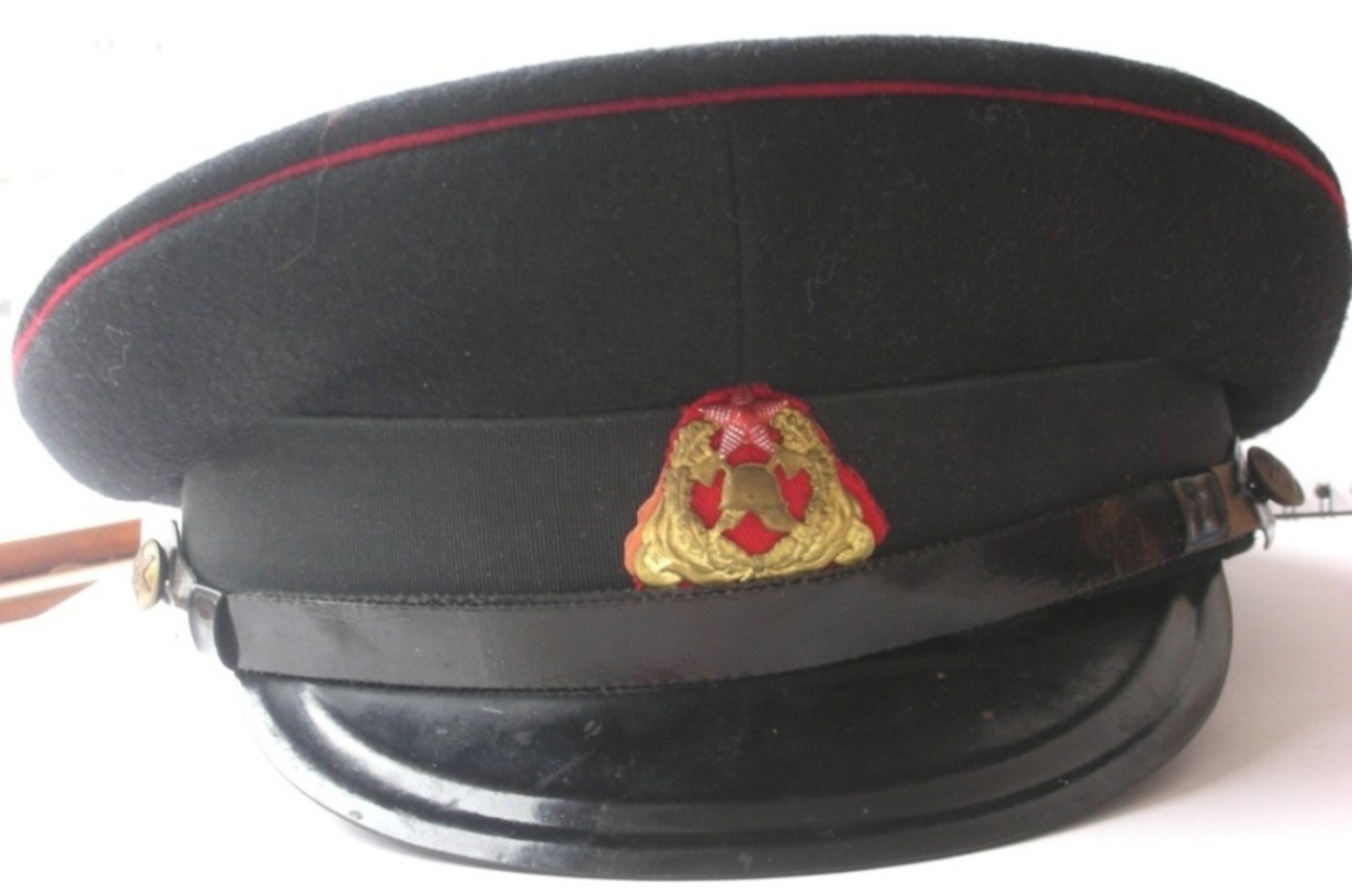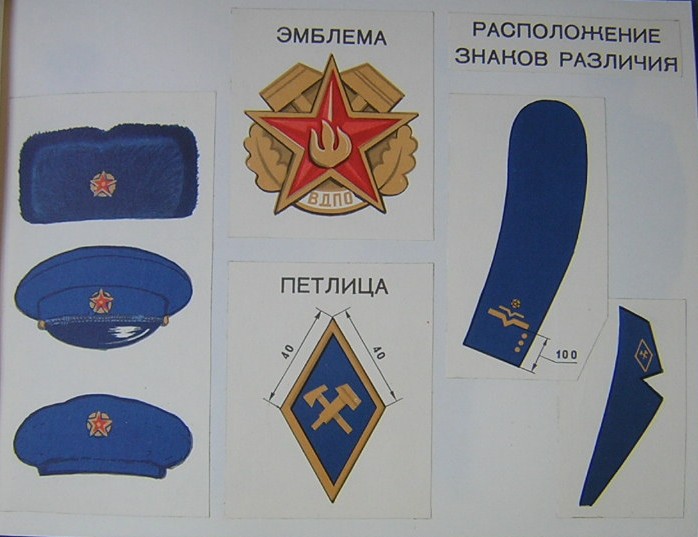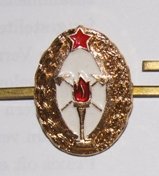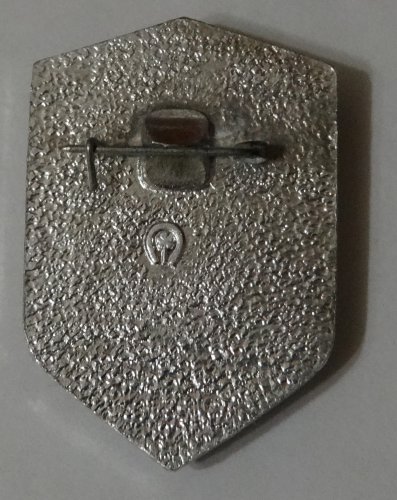 Civilian Fire Defense Caps
Civilian Fire Defense CapsFire protection has always been considered of vital importance in the USSR given its heavy industrialization; historical reliance on wooden structures and the militarized nature of the economy – where any losses due to fire (especially in industry) were considered as weakening the country’s ability to defend itself against outside enemies. Consequently, during the Soviet period, the management of fire protection was exercised by the Ministry of Internal Affairs (NKVD-MVD). It was overall responsible for the formation, regulation and readiness of all fire-fighting organizations, including civilian ones. For most of the post-war period, there existed four “types” of Soviet fire protection organizations.
At the apex of the firefighting hierarchy were the “militarized” or “paramilitary” units responsible for major population centers, military and security garrisons and key industrial and economic concerns. Fire-fighters assigned to these units wore uniforms only slightly different from their interior troop cousins but with crossed wrench collar and sleeve insignia indicating their fire defense status . During one of my visits to Moscow, I walked past a MVD fire defense motorpool - guarded by a private indistinguishable from any other MVD conscript except for this collar insignia. Caps from this force are not shown on this page - since they were identical in every way to those caps worn by the MVD troops shown on my MVD/NKVD/NKGB/MGB page.
A second type was directly subordinate to important Ministries and agencies such as Mining, Forestry, Railways and Civil Aviation. Personnel wore the uniforms and caps of their parent organizations and are covered on my pages dedicated to those agencies. Consequently, my focus here will be on the last two types of fire-fighting organizations: Professional and Volunteer.
Professional Fire Protection or PPO (in Russian ППО = Профессиональной Пожарной Охраны) units were directly organized, outfitted and supervised by the MVD. PPO provided fire protection for important towns and cities and key objects of the economy not covered by militarized units. Personnel assigned to these units were authorized uniforms and were categorized (as in many other non-military organizations) as senior, middle and junior staff or as rank and file.
Volunteer Fire Protection Companies (in Russian ДПО = Добровольное Пожарное Общество; the largest of which was the Всероссийское Добровольное Пожарное Общество (ВДПО) or "All-Russian Volunteer Fire Protection Society") made up arguably the lowest level of the Soviet fire-fighting hierarchy. These companies were typically formed in smaller population centers and concerns not covered by the previous organizations. These companies were regulated by republic governments but still monitored by the MVD. The majority of personnel in these companies did not wear uniforms as a matter of course, although most republics did authorize some elements of uniform for more senior staff and distinguishing insignia for all. Although these volunteer “uniforms” seemed to largely mirror those used by the PPO, some republics (like Estonia) adopted more unique ones.
Professional Fire Protection
Fireman
1950's
The oldest fireman's cap in my collection - this one dates from the 1950s and has all the features characterizing Soviet caps of that era. The visor is "spade-shaped" black-painted fiberboard, the standard for caps made in the 1940s; prior to the Soviet military
changing to a semi-circular design in 1954 (which was subsequently adopted by other uniformed sectors). The crown is napped wool. Overall color, including piping, is very dark (or midnight) blue - appearing black in some light. This color was the standard for civilian fire-protection organizations throughout
the Soviet period, with some variance as seen below in the Estonian cap. The black oil-cloth chinstrap was also standard up to 1991, apparently worn even by supervisors. This was held in place
by two Army-style brass and steel buttons (the PPO did not have its own button design). Finally - the emblem of the PPO (crossed wrench, fireman's ax and hose nozzle) was stamped from thin brass on these early caps and pinned through the band.
Scarce
Professional Fire Protection
Fireman
1960's
The cap described above evolved into this style in the 1960s. The color and fabric remained the same. The crown is still the smaller 1960s size and is sewn from napped wool.
The visor, however, is now smaller and semi-circular in shape although still made of black lacquered fiberboard. The strap is oilcloth with a plastic coating and the buttons are standard Army-style.
The cockade is now aluminum, which reportedly became standard in 1964.
Scarce
Professional Fire Protection
Fireman
1980s-1991
One of the final evolutions of the fireman's cap - this one is dated 1989. Note the crown is larger in both circumference and height. This style crown became standard
in the 1970s. Fabric used in these later caps was also modernized. While the band and piping are still very dark blue, the blended wool
crown is not as dark and cannot now be mistaken for black. The visor is larger and made of plastic - reflecting another trend seen in the 1980s. The chinstrap is also now
all plastic. The anodized aluminum cockade remains the same, although very late versions lost some of their definition compared to earlier aluminum versions.
Available
| Although I don't have them all mounted on my display caps, there were at least four main variants of PPO cockades (with sub-varients of each of those). Each depicted a crossed wrench and fireman's ax and a firehose nozzle, surrounded by a wreath. The oldest, and most finely made cockade was manufactured as a heavy two-piece stamped brass oval with dark blue hot enamel. This is shown on the extreme left of the first picture below and reportedly was intended for supervisors as of 1956. The other two shown in the first picture are brass and aluminum versions reportedly intended for the "rank and file" of the PPO. The brass models were produced from the late 1950s while aluminum versions were produced from the mid-1960s and remained standard in the later years of the USSR. Shown separately is a one-piece tombac cockade with light blue enamel which apparently superseded the 1956 supervisor's cockade - probably in the 1960s. |
|
|
|
|
Estonian Volunteer Fire Protection
Fireman
1960's
While most Soviet republics followed the Russian "model" in terms of PPO uniforms, the Baltic republics took a slightly different track, incorporating their own historical elements. Estonian - and apparently Latvian - uniforms were officially black (vice very dark blue) and had red distinctions, manifested in red piping around the crown of their caps. This particular cap dates from the 1960s; with a small napped wool crown and a black fiberboard visor. The chinstrap is oilcloth and buttons are Soviet Army. Two other unique features of the Estonian/Latvian PPO were the navy-style ribbon worn around the band and the unique cockade. This ribbon was authorized in Estonian regulations of 1957 - although those initial regulations called for a ribbon embossed with oak leaves. However, every picture I've seen of actual caps just have a plain Navy-officer style ribbon. I presume more senior fire officials made sure they acquired the fancier ribbons for wear. The cockade is rather old-fashioned in design, depicting crossed fire axes with a superimposed fireman's helmet. This is in turn surrounded by a wreath depicting oak leaves and - at the bottom - flames. A star crowns the emblem. This star can be either stamped as part of the brass emblem or - as in this case - a separate piece utilizing an Army rank star. This star is often - but not always - painted red.
A variant of this cap from a Russian collection is shown below. The cap is the same, even to the naval-style ribbon on the band. However, a swatch of red fabric was added
behind the cockade for greater visual effect.
 Scarce
Scarce
| As previously mentioned, volunteer firemen - especially among rank and file outside the Baltic republics - typically did not wear uniform caps. However, the RSFSR Council of Ministers did authorize wear of uniforms (unfortunately not further described) by the All-Russian Volunteer Fire Protection Society (ВДПО) on July 13, 1966. At least two and possibly three of the cockades shown below were associated with this Society, although none seemed to have been worn in any numbers. |



